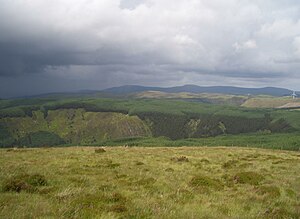Cambrian Mountains
The Cambrian Mountains are a series of mountain ranges in the midst of Wales.
Originally the term "Cambrian Mountains" was applied in a general sense to most of upland Wales. Since the 1950s, its application has become increasingly localised to the geographically homogeneous Mid Wales uplands, known in the Welsh language as the Elenydd, which extend from Plynlimon to Mynydd Mallaen, which is to say from the north-western borders of Cardiganshire down into Carmarthenshire. This is a barren and sparsely populated wilderness, often referred to as the Desert of Wales. The Cambrian Mountains were unsuccessfully proposed as a National Park in the 1960s and 1970s.
The Cambrian Mountains include the sources of the River Severn and River Wye. The highest point of the range is Plynlimon, at 2,467 feet, which is also the highest point of Cardiganshire. They cover parts of Merionethshire, Cardiganshire, Montgomeryshire, Radnorshire, Brecknockshire and even Carmarthenshire.
The wider use of the term "Cambrian Mountains" may encompass much of the montainscape of Wales, to include Snowdonia in Caernarfonshire, and the Brecon Beacons and Black Mountains to the south. These more widely cast bounds have mountains in height up to 3,560 feet at Snowdon in Snowdonia.
Contents
Geology and topography
While Snowdonia contains a mix of volcanic rocks and sedimentary rocks of Cambrian and Ordovician age, the mountains of South Wales are mainly Devonian age Old Red Sandstone and Carboniferous Limestone and similarly aged sandstones. The ranges of mid Wales on the other hand are predominantly formed from Ordovician and Silurian sandstones and mudstones which in many areas outcrop only infrequently so resulting in more rounded grassy hills. The geological terms "Cambrian", "Ordovician" and "Silurian" are taken from the observation of these mountains and the latter two from the tribes which anciently inhabited them.
The Cambrian Mountains (in the modern, narrower sense of the term) are generally less popular with hillwalkers and scramblers than the ranges to their north and south, but frequented by mountain cyclists, hill-walkers and many other adventurous types. Cadair Idris in Merionethshire has a particular reputation. It was said that a man who sleeps on Cadair Idris will become blind or mad or a poet; many take the challenge, and not infrequently come to the attention of the Mountain Rescue teams.
Since all of Wales' ranges face the predominant westerly air stream coming in from the Atlantic Ocean, they enjoy high levels of rainfall and are the source of numerous rivers, among which the rivers Severn and Wye, which rise on the eastern slopes of Plymlimon, are the largest.
Dams and wind farms
The Cambrian Mountains host the Elan Valley Reservoirs and Llyn Brianne reservoir, which provide water for the western Midlands and for south Wales respectively. They include the Clywedog Reservoir and Nant y Moch Reservoir. Cefn Croes, the site of a controversial wind farm project, is in the Cambrian Mountains, just south of the A44 road between Aberystwyth and Llangurig.[1][2][3]
National Park proposal
The area was proposed as a National Park in 1965 by the National Parks Commission, a precursor body of the Countryside Commission. However, the proposal was opposed by many farmers and local authorities in the area. Formal consultations on the proposal began in 1970, and in 1971 the Countryside Commission proposed a revised boundary for the designation. The proposed area, of 467 square miles, covered the area of Plymlimon and Elenydd, within an area bounded by the settlements of Machynlleth, Llangurig, Rhayader, Newbridge-on-Wye, Llanwrtyd Wells, Llandovery, Pumsaint, Tregaron, and Devil's Bridge. Despite continuing local opposition, the Countryside Commission published the order designating the area on 15 August 1972, and submitted it to the Secretary of State for confirmation.[4][5]
Objections to the proposed designation were then made by all five county councils, 5 of the 7 district councils, 5 parish councils, the National Farmers Union, the Country Landowners Association, Plaid Cymru, the Campaign for the Protection of Rural Wales and others. Support for the designation was expressed by the Ramblers' Association, Youth Hostels Association, and Cyclists' Touring Club. In July 1973, the Secretary of State announced the decision not to proceed with the designation because of "massive evidence of objections", and also rejected a call to hold a public inquiry. This was the first time such a recommendation on national park designation had not been accepted.
Principal summits
| Plynlimon (Pen Pumlumon Fawr) | 2,467 feet | Cardiganshire | |
| Pen Pumlumon Arwystli | 2,431 feet | Cardiganshire / Montgomeryshire | |
| Pen Pumlumon Llygad-bychan | 2,385 feet | Cardiganshire / Montgomeryshire | |
| Y Garn | 2,244 feet | Cardiganshire | |
| Pumlumon Fach | 2,192 feet | Cardiganshire | |
| Great Rhos | 2,165 feet | Radnorshire | |
| Black Mixen | 2,133 feet | Radnorshire | |
| Drygarn Fawr | 2,116 feet | Brecknockshire | |
| Gorllwyn | 2,011 feet | Brecknockshire | |
| Bache Hill | 2,001 feet | Radnorshire | |
| Pen y Garn | 2,001 feet | Cardiganshire | |
| Y Gamriw | 1,982 feet | Brecknockshire | |
| Llan Ddu Fawr | 1,946 feet | Cardiganshire | |
| Pegwn Mawr | 1,923 feet | Montgomeryshire | |
| |
Pictures
Outside links
- The Cambrian Mountains Society
- The Cambrian Mountains Initiative
- Cambrian Mountains tourism guide
- Cambrian Mountains walking guide
References
- ↑ "Cefn Croes Wind Project". Power Technology. 2011-06-15. http://www.power-technology.com/projects/cefn_croes/. Retrieved 2012-03-28.
- ↑ "Cefn Croes is close to Aberystwyth. - Image". Power Technology. 2011-06-15. http://www.power-technology.com/projects/cefn_croes/cefn_croes5.html. Retrieved 2012-03-28.
- ↑ "Cefn Croes Wind Farm - Official Campaign website". Users.globalnet.co.uk. 2003-09-20. http://www.users.globalnet.co.uk/~hills/cc/. Retrieved 2012-03-28.
- ↑ "Cambrian Mountains National Park story". Cambrian-mountains.co.uk. 2011-03-06. http://www.cambrian-mountains.co.uk/np-story.php. Retrieved 2012-03-28.
- ↑ Cambrian Mountains Society: National Park Timeline 1872-1973. Accessed 29 March 2012







